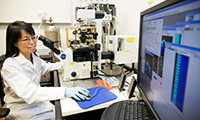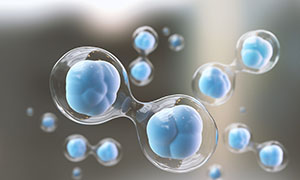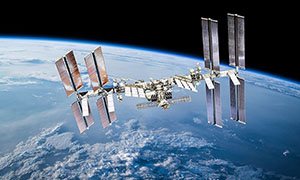Cardiac Stem Cells
Growing Cardiac Cells in Space Offers Exponential Promise on Earth
The work of Chunhui Xu, PhD, is out of this world – literally. In March 2020, on a resupply mission to the International Space Station, NASA’s SpaceX-20 was carrying one of her experiments: stem cells to be grown in zero-gravity.
This experiment, developed in partnership with Emory professor Kevin Maher, MD, is the product of many years studying cardiogenesis (the study of the embryonic heart). Xu’s expertise is in human pluripotent, or immature, stem cells (hPSCs) which can be turned into cardiac muscle cells. For this stellar experiment, Xu and Maher hoped to grow stem cells into beating heart cells faster in the space environment.

Chunhui Xu, PhD
A breakthrough for cell research – no gravity required
As associate professor of pediatrics at Emory University School of Medicine, Xu and her lab study the growth and differentiation of human stem cells and develop technologies to facilitate the use of hPSC-derived heart cells for disease modeling, drug screening, and regenerative medicine.
Stem cell-derived cardiac muscle cells have been used to treat heart failure in animal models and have been used to study inherited cardiac diseases separately from the heart of the source patient. Although these cells have great potential for cell therapy, the volume required is challenging: At least one billion heart cells are needed to repair a damaged heart.
As cardiovascular disease is the leading cause of death for U.S. adults and congenital cardiovascular defects are a common cause of infant death resulting from birth defects, Xu and Maher’s work is essential. But it takes time to grow stem cells into heart cells, especially at high volume.
Xu looked beyond standard culture methods for other means of efficiently producing the cells. She found it in a simulated microgravity environment.

Stem Cells
“When we exposed stem cells to microgravity in a bioreactor in our lab, we were able to produce a lot more beating heart cells than when the stem cells were grown in standard gravity,” she said.
More stem cells grown at a faster rate? Mission accomplished – for now. The next logical testing ground was space, and soon, Xu’s experiment was accepted as part of NASA’s resupply mission.
Freezing cells for better results
Getting cultures of live cells into space and back safely is complex, requiring enough cells, pretesting to make sure they are of good quality, and — trickiest of all — timing.
“Because these cells are continuing to grow, you need to time everything perfectly to fit the launch schedule and astronauts’ schedule so that these cells will be in the right stage and condition when they reach the International Space Station,” said Xu.
There had to be a better way, and Xu and Maher found it: cryopreserving cells in 3D constructs. This method does away with CO2, normally needed on Earth and in space to stabilize the pH of the cultures. Its use, though, takes up precious cargo area on space flights.
Cryopreservation, on the other hand, has multiple benefits:
- Allows for better pretesting of the cells before spaceflight
- Makes it easier to transport the cell culture
- Reduces the impact of strong gravitational force exerted on the cells during launch
- Accommodates a more flexible working schedule for the astronauts
A February 2021 article in Biomaterials detailed the promising findings resulting from the mission, which showed that these stem cells grow faster in the zero-gravity conditions of space. The clinical implications are promising, including the possibility of children with damaged hearts receiving replacement tissue grown from their own cells. It could also open a new door to personalized medicine. For example, a child with heart arrythmia could get a biopsy and their own cells could be grown to test medications and treatments.
Stellar outcomes for zero-gravity experiments
Back on Earth, Xu received a grateful nod from the ISS National Laboratory, who touted her cryopreservation technology as an avenue for future space research involving cells.
Astronaut Jessica Meir, who oversaw the experiment on SpaceX-20, described the experience as an “incredibly rewarding process for me as a scientist to see this experiment come to light, to know that it represents years of hard work from these scientists on the ground.”

International Space Station
Freezing cells isn’t only useful for spaceflight. Xu looks forward to cryopreservation’s use back on the ground, too. Among its benefits, says Xu, is easier transportation of live cells and more efficient means of studying cells in devices, such as a microscope, that don’t have a CO2 supply.
Also, said Xu, “Cryopreservation is likely preferable for cell therapy since it allows enough time for pretesting the quality of cell preparations prior to transplantation and confirmation of sufficient quantity of cells for transplantation.”
For Shweta Ghai, licensing associate in Emory’s Office of Technology Transfer, it’s not only an honor to work with a world-renowned expert in cardiogenesis, but also a joy to interact with a scientist so respectful of the team helping to license the technology she developed. “Who she is as a person and communicator is as impressive as her knowledge of the heart. I feel confident that her continued research will result in effective therapies for cardiovascular issues,” said Ghai.
Boldly going forward in cell research
Looking back on her groundbreaking project, Xu reflected, “Dr. Maher and I are thrilled that our hypothesis about the effect of microgravity on heart stem cells has been validated in this space experiment, one that received great support from the Center for the Advancement of Science in Space. The dedication of many talented scientists, engineers, and astronauts contributed to this research endeavor.”
Moving forward, Xu and Maher will continue their investigation into how microgravity affects heart stem cells. Their hope is to translate this research into potential regenerative cell therapy for pediatric patients – saving thousands of young lives in the process.
Tech ID: 20186
Read our technology brief
Emory News Articles
Cardiac cells that beat in space offer hope for better heart treatment on earth https://news.emory.edu/features/2021/07/cardiac-cells-in-space/
Space station will host stem cells for heart research https://news.emory.edu/stories/2017/10/xu_stemcells_space/